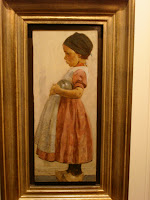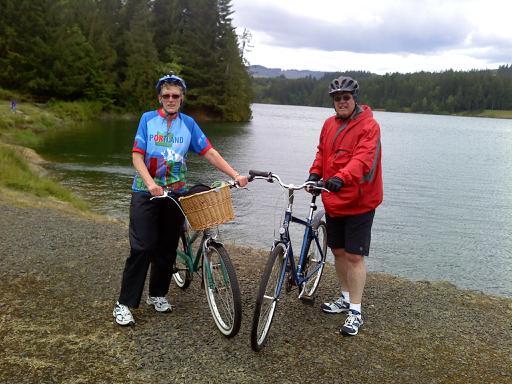 We left the village of Volendam in two groups, the short-ride group on the ferry (Wm.) and the long ride group by bike (Pat) to go to the island of Marken. On the way we biked through Monnickendam, a small village founded by monks. After the passage to the North Sea was closed by the dam which created the Ijsselmeer, the villagers had to change from a sea-fishing vocation to a lake-fishing vocation. These are mackerel (and below eel) that are typically caught in the Ijsselmeer and smoked in this place in Monnickendam using pine wood. We also tried some raw herring which is served with raw onions, and some smoked herring. Not something I'd eat every day, but not bad.
We left the village of Volendam in two groups, the short-ride group on the ferry (Wm.) and the long ride group by bike (Pat) to go to the island of Marken. On the way we biked through Monnickendam, a small village founded by monks. After the passage to the North Sea was closed by the dam which created the Ijsselmeer, the villagers had to change from a sea-fishing vocation to a lake-fishing vocation. These are mackerel (and below eel) that are typically caught in the Ijsselmeer and smoked in this place in Monnickendam using pine wood. We also tried some raw herring which is served with raw onions, and some smoked herring. Not something I'd eat every day, but not bad.
 The island of Marken is connected to the shore by a dike road. It's known for the houses built on stilts to withstand floods from storms and for the villagers who typically wear elaborate costumes. This is the vest from a woman's costume. The printed fabric on the front is typically batik brought from the Far East (historically by Dutch East India Co. traders) and used to ornament the plain striped fabric on the sides.
The island of Marken is connected to the shore by a dike road. It's known for the houses built on stilts to withstand floods from storms and for the villagers who typically wear elaborate costumes. This is the vest from a woman's costume. The printed fabric on the front is typically batik brought from the Far East (historically by Dutch East India Co. traders) and used to ornament the plain striped fabric on the sides. This wa the first day on the job for this 16-year-old girl from Marken, who worked in a house serving as a demonstration of what the typical Marken home looked like in the past. An old lady died and left her home as a sort of museum for visitors. The most interesting thing was the beds, which were located in small open cupboards in the wall which could be closed by curtains and which were about 4 feet off the ground. People slept sitting up, so the cupboards were short. Under the adult bed cupboard was a small hole in the wall leading to another, smaller cupboard on the floor, where the children slept.
This wa the first day on the job for this 16-year-old girl from Marken, who worked in a house serving as a demonstration of what the typical Marken home looked like in the past. An old lady died and left her home as a sort of museum for visitors. The most interesting thing was the beds, which were located in small open cupboards in the wall which could be closed by curtains and which were about 4 feet off the ground. People slept sitting up, so the cupboards were short. Under the adult bed cupboard was a small hole in the wall leading to another, smaller cupboard on the floor, where the children slept. These are two sisters, ages 82 and 78, who run the museum on Marken. They said on the whole island there are only 4 or 5 women left who wear typical costumes these days and they are all dying out. To be authentically dressed, each woman must make her own costume, and they are quite elaborate. If you come to Marken in a few years all you'll see is someone like the young girl above, dressed in a commercially made costume solely for the benefit of the tourist trade. Sad, but a sign of modern progress.
These are two sisters, ages 82 and 78, who run the museum on Marken. They said on the whole island there are only 4 or 5 women left who wear typical costumes these days and they are all dying out. To be authentically dressed, each woman must make her own costume, and they are quite elaborate. If you come to Marken in a few years all you'll see is someone like the young girl above, dressed in a commercially made costume solely for the benefit of the tourist trade. Sad, but a sign of modern progress. Typical very old Dutch house -- made of wood. They're usually painted green or black. Black was original color and came from tar applied to the wood to waterproof it. This house is on the island of Marken, where houses were built on stilts because the dike was low and the island occasionally flooded during storms.
Typical very old Dutch house -- made of wood. They're usually painted green or black. Black was original color and came from tar applied to the wood to waterproof it. This house is on the island of Marken, where houses were built on stilts because the dike was low and the island occasionally flooded during storms. The lighthouse at Marken. The ship in the left background has the traditional brown sails. In the olden days the sailors coated their cloth sails with tar to prevent them from wearing out soon. Traditional ships still use brown sails in honor of that history. We saw many, many two and three-masted sailing ships on the Ijsselmeer.
The lighthouse at Marken. The ship in the left background has the traditional brown sails. In the olden days the sailors coated their cloth sails with tar to prevent them from wearing out soon. Traditional ships still use brown sails in honor of that history. We saw many, many two and three-masted sailing ships on the Ijsselmeer. This is how you get your bike down from a dike. We were riding along the top of the dike to the village of Marken but needed to use the road in the foreground. Next to the steps is a small gutter on each side. You run the bike wheels down the gutter while you descend the stairs. Somewhat tricky but doable.
This is how you get your bike down from a dike. We were riding along the top of the dike to the village of Marken but needed to use the road in the foreground. Next to the steps is a small gutter on each side. You run the bike wheels down the gutter while you descend the stairs. Somewhat tricky but doable. Typical 17th century Dutch house (but the light blue color not so typical. The door in the front is called a death door. It has no steps leading to it and no handle. Opens only from the inside and is traditionally used only on two occasions: 1) Death -- the body is removed from the house through this door and 2) Marriage -- The bride exits her family home through this door, marriage being symbolically like a death in that the bride leaves her home and family and must start a new life.
Typical 17th century Dutch house (but the light blue color not so typical. The door in the front is called a death door. It has no steps leading to it and no handle. Opens only from the inside and is traditionally used only on two occasions: 1) Death -- the body is removed from the house through this door and 2) Marriage -- The bride exits her family home through this door, marriage being symbolically like a death in that the bride leaves her home and family and must start a new life. 99 Delft tiles in a church, telling the story of the Bible from creation to second coming. Because people couldn't read, the pastor used the tiles to illustrate his message and to provide a way for the people to understand the Bible.
99 Delft tiles in a church, telling the story of the Bible from creation to second coming. Because people couldn't read, the pastor used the tiles to illustrate his message and to provide a way for the people to understand the Bible.We are now back in Amsterdam, where William and I have one more free day before we catch a train to Dresden, Germany. We'll visit a commercial laundromat first thing to get our clothes washed in a better fashion than our wash-in-the-sink biking mode, and then do a bit of tourism, Amsterdam-style. Probably won't blog again til we're in Germany, if then, depending on internet access.
We had a raucous farewell party last night on the barge, as it was the last night our guides were with us on the boat. They did a biking tourist-style skit for us and we sang a couple of song parodies in honor of our trip. It was truly a fun experience, and I can't think of a better way to see the country. I'd highly recommend it. Doesn't require a buff body, as you can elect to stay on the barge all day, bike the short route with lots of stops for photos and/or coffee and/or treats, or the longer route, which also has stops for info on what you're seeing, as well as lunch and coffee stops. We'd do it again in a heartbeat and may, indeed, return for another trip on a different route through the Netherlands.














































